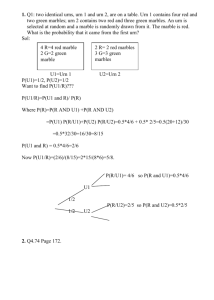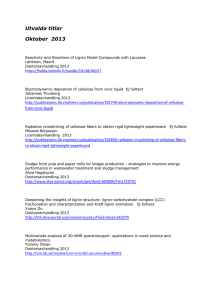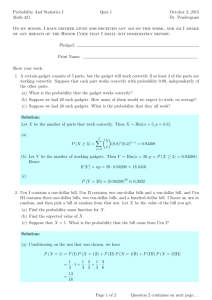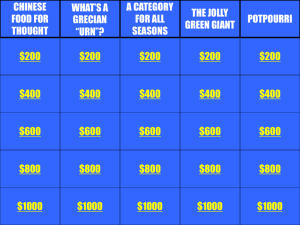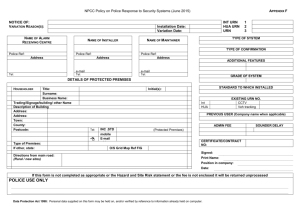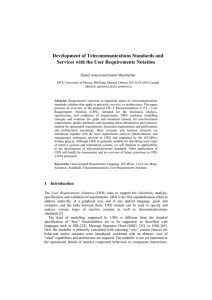User Requirements Notation (URN)
advertisement
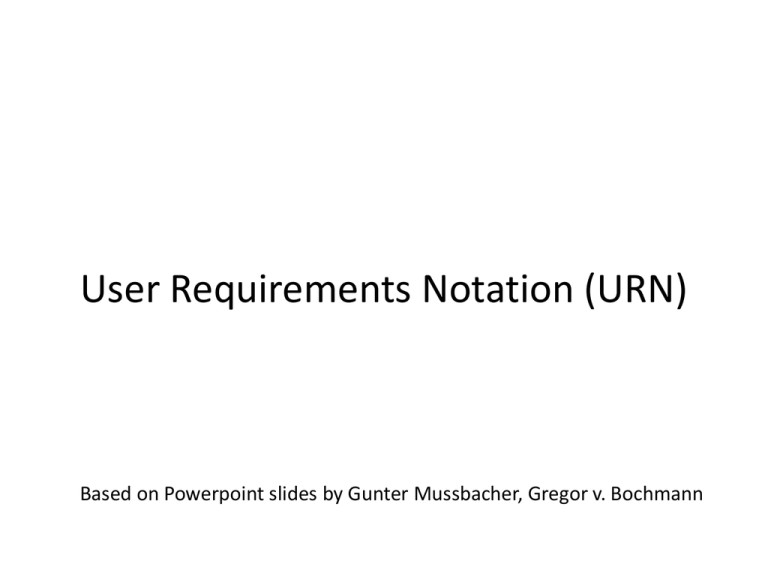
SEG3101 (Fall 2010) User Requirements Notation (URN) Based on Powerpoint slides by Gunter Mussbacher, Gregor v. Bochmann Table of Contents • Introduction to the User Requirements Notation (URN) – User Requirements Notation – jUCMNav Tool • Goals and Rationale • Goal-oriented Requirement Notation (GRL) – GRL Basics – Evaluations – Examples – Tools – Metamodel • All models are false but some models are useful.1 [1] George Edward Pelham Box (1919-) 2 Modeling Puzzle – Common View Informal Requirements, Textual Use Cases Structural Diagrams: SDL, eODL, or UML class, object, component, & deployment diagrams MSC, UML Use Case & Activity Diagrams Behavioral Diagrams: MSC/SDL, or UML sequence, collaboration, & statechart diagrams DATA Can we do better to bridge this gap? Testing and Performance Languages: TTCN, LQN, ... Introduction to the User Requirements Notation (URN) URN Overview (1) • URN is a semi-formal, lightweight graphical language for modeling and analyzing requirements in the form of goals and scenarios and the links between them • Combines two existing notations – Goal-oriented Requirement Language (GRL) (based on i* & NFR Framework) – Use Case Maps (UCMs) • Support for the elicitation, analysis, specification, and validation of requirements • Allows systems, software, and requirements engineers to discover and specify requirements for a proposed system or an evolving system, and analyse such requirements for correctness and completeness 5 URN Overview (2) • URN models can be used to specify and analyze various types of reactive systems, business processes, and telecommunications standards • jUCMNav – URN editor & analysis tool – Eclipse plug-in – Open source project 6 URN Overview (3) vision GRL Model business goals, stakeholders’ priorities, alternative solutions, rationale, and decisions traceability with URN links extensible with metadata UCM Model & test use cases; investigate high level architecture; transform to more detailed models called strategies, compared with GRL evaluation mechanism with UCM traversal mechanism based on UCM scenario definitions more detailed models A GRL / UCM model visually communicates business objectives and constraints / high-level functional requirements to all stakeholders Combination of Goals and Scenarios • URN combines two complementary parts: – The Goal-oriented Requirement Language (GRL) • For modelling goals and other intentional concepts (mainly for nonfunctional requirements, quality attributes, and reasoning about alternatives and tradeoffs) – The Use Case Map (UCM) notation • For modelling scenario concepts (mainly for operational requirements, functional requirements, and performance and architectural reasoning) • URN offers concepts for the specification of stakeholders, goals, non-functional requirements, rationales, behaviour, scenarios, scenario participants (actors), and high-level architectural structure 8 URN – Main Objectives • Focus on early stages of development with goals and scenarios • From user requirements to functional and non-functional system requirements • No messages, components, or component states required • Reusability – of argumentations (goal patterns and analysis) – of scenarios (patterns and architectural alternatives) • Early performance analysis • Traceability and transformations to other languages – Particularly MSC, SDL, TTCN, and UML – Also to LQN, LOTOS, and others 9 ITU-T Z.151: URN – Language Definition • URN is the first and currently only standard which explicitly addresses goals (non-functional requirements with GRL) in addition to scenarios (functional requirements with UCMs) in a graphical way in one unified language – International Telecommunication Union (ITU-T Z.150 series) – ITU-T Z.150 (02/03): User Requirements Notation (URN) - Language requirements and framework – ITU-T Z.151 (11/08): User requirements notation (URN) - Language definition • Part of the ITU family of languages: SDL, MSC, TTCN-3… • Definition of URN in Recommendation Z.151 (approved November 2008) – Metamodel, abstract/concrete syntaxes, semantics… 10 ITU-T Z.150: http://www.itu.int/rec/T-REC-Z.150/en ITU-T Z.151: http://www.itu.int/rec/T-REC-Z.151/en About ITU-T • International Telecommunication Union • United Nations organization – 191 countries + hundreds of member companies • Free access to the definition of many standard languages – http://www.itu.int/ITU-T/studygroups/com17/index.html • Question 13 (Formal languages and telecommunication software) of Study Group 17 (Security) – Z.15x User Requirements Notation (URN) – Also SDL, MSC, and profiles • Other international bodies standardize languages – ANSI (C, C++), W3C (HTML, XML), IEEE (VHDL), ISO (LOTOS), OMG (UML), OASIS (XACML), etc. 11 ITU-T Languages • SDL: Specification and Description Language – For defining and executing complete reactive systems • MSC: Message Sequence Charts – For defining message-oriented scenarios • ASN.1: Abstract Syntax Notation One – For defining data types/packets • TTCN-3: Testing and Test Control Notation – For defining test cases and test environments • URN: User Requirements Notation – Goal-oriented Requirements Language (GRL) – Use Case Map notation (UCM) – For defining abstract goals, scenarios, and requirements • UML 2.0 profiles for some of these languages on their way… 12 UML Puzzle Use Cases and UML 2.0 Use Case Diagrams UML 2.0 Structural Diagrams Goal-oriented Requirement Language (GRL) Use Case Maps (UCMs) UML 2.0 Behavioral Diagrams UML 2.0 Activity Diagrams Testing Language ? GRL captures stakeholders’ business goals, alternatives, decisions, and rationales. Alternatives in GRL are linked with more detailed models described as UCMs. UCMs represent visually use cases in terms of causal responsibilities. UCMs provide a framework for making high level and detailed design decisions. UCMs visually associate behavior with structure at the system level. UCMs enable functional testing and allow the generation of test purposes. ITU Puzzle Informal Requirements, Textual Use Cases (M.3020) Structural Diagrams: SDL (Z.100) Goal-oriented Requirement Language (GRL) GRL captures stakeholders’ business goals, alternatives, decisions, and rationales. Alternatives in GRL are linked with more detailed models described as UCMs. UCMs represent visually use cases in terms of causal responsibilities. Use Case Maps (UCMs) UCMs provide a framework for making high level and detailed design decisions. Data ASN.1 (X.680) where appropriate Behavioral Diagrams: SDL, MSC (Z.120) Testing Language: TTCN (Z.140) UCMs visually associate behavior with structure at the system level. UCMs enable functional testing and allow the generation of test purposes. Transformations • Transformations connect URN models to other models • Some transformations discussed in publications or implemented in jUCMNav’s predecessor UCMNav have not yet been implemented in jUCMNav Requirements – Test Cases (Fitnesse, TTCN) – UML activity/sequence/state/use case diagrams – SDL Textual Use Cases (UCEd *) User Requirements Notation (jUCMNav) Management (Telelogic DOORS) Core Scenario Model (CSM) (for performance modeling) Message Sequence Charts (MSC Viewer) * Stéphane Somé’s UCEd: https://sourceforge.net/projects/uced/ Summary • The User Requirements Notation (URN) is an ITU-T standard • Modeling with the Goal-oriented Requirement Language – Focuses on answering “why” questions – Intentions, functional / non-functional requirements, rationales • Modeling with Use Case Maps – Focuses on answering “what” questions – Scenarios, services, architectures • While modelling with URN as a whole, goals are operationalized into tasks, and tasks are elaborated in scenarios (mapped to UCM path elements) – Moving towards answering “how” questions – Can guide the selection of an architecture or scenarios • Enables the elicitation/specification of systems, standards, & products, analysis from various angles, & transformations 16 URN Tool: jUCMNav – Juice Up Your Modeling! • • • GRL Strategies Evaluation • • • • UCMs Scenario Definition Scenario Execution Test Suite • • • MSC Generation Export to DOORS Export to CSM Pronounced: juicy – em – nav http://jucmnav.softwareengineering.ca 17 URN Tool: jUCMNav – Overview (1) • Free (EPL), open-source plug-in for Eclipse – Based on Eclipse Modeling Framework (EMF) and the Graphical Editing Framework (GEF) • Supports most of GRL and UCM notation elements • Extensible architecture for customized GRL and UCM analysis techniques • 4 GRL evaluation algorithms, with color highlight • 1 UCM path traversal mechanism, with export to flat UCMs and MSCs – Integrated MSC viewer 18 URN Tool: jUCMNav – Overview (2) • Other features – Export performance models to CSM – Integration with DOORS for requirements management – Extensions for Business Process Modeling, Monitoring, and Adaptation – Extensions for aspect-oriented modeling with AoURN – Verification of user-defined (OCL) rules – Report generation (PDF, HTML) – Export of diagrams to various bitmap formats 19 GRL Editor with Strategy Evaluation Toolbar Navigator view Editor Outline view Palette Scenarios and Strategies view Properties view UCM Editor with Scenario Traversal Perspective Graphical Outline Problems view Integrated MSC Viewer for Exported UCM Scenarios MSC viewer Outline view
